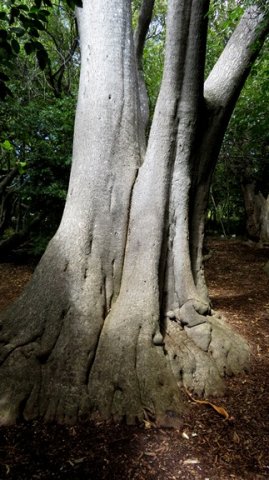Aloidendron barberae trunk lower branches

Author: Ivan Lätti
Photographer: Thabo Maphisa
Forest strollers may see many trunks, while wondering about other tree parts up high, difficult to see clearly when on foot. This Aloidendron barberae trunk shows its characteristic, spreading foot, some branching and surface fluting. Growing among other trees its stem is in shade, quite grey and pale, appearing smooth.
Rebranching continues high up, the leaves in rosettes at every branch-tip. Branching in A. barberae is said to start or multiply from midway, but early, lower branching points do not move up in older stem parts. Stem lengthening occurs often continuously, varied seasonally, near stem-tips.
Older A. barberae trees continue height increase, albeit at slowing rate, as lateral branching or spreading benefit much from growth efforts of the really large specimens. This is the expansion pattern in solitary trees.
Forest trees have to invest more in height, less in their natural lateral tendencies for continual matching of the forest canopy height. This is achieved jointly among the close neighbours and gradually increased. This, or lose their places in the sun and thereby eventually their lives.
In habitat A. barberae often finds itself in forest conditions and does the necessary: fewer branches and thinner trunk as the needs dictate. A stand-alone tree has to face wind on its own. Forest trees share wind resistance and get away with thinner trunks in storms (Schmidt, et al, 2002; Pooley, 1993).

